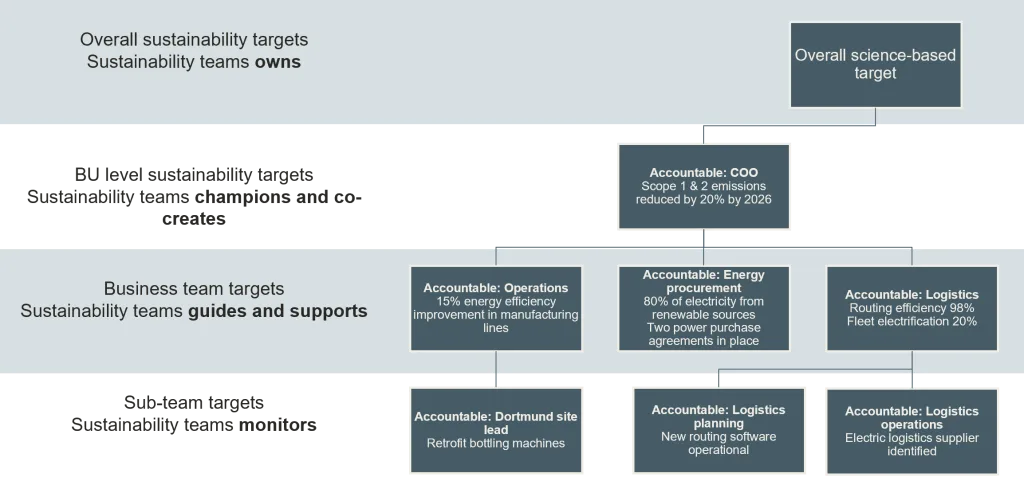The Business Action Guide to Climate Transition: Making the Business Case and Implementing the Transition helps sustainability leaders and senior decision-makers move from climate ambition to delivery. Co-developed by WBCSD and the Carbon Trust, and informed by insights from 27 global companies, the guide provides practical tools, evidence frameworks, and organizational strategies to help companies help companies drive real momentum for their climate transition, from stakeholders buy-in to implementation across the business.
Why this Guide matters
Setting climate targets is a meaningful achievement — but it’s only the beginning.
Across sectors, sustainability teams face rising expectations to convert ambition into investments, operational change, and measurable progress. Many report similar obstacles: difficulty securing leadership buy-in, limited financial evidence, misaligned incentives, inconsistent KPIs, and transition plans that look strong in theory but stall in practice.
Findings from the Climate Next Frontiers initiative highlight these tensions clearly:
- 79% say a strong ROI is the most persuasive internal argument, yet 57% have not quantified the financial benefits of their transition plan.
Source: Survey from 14 WBCSD members – August 2025
- 100% link executive compensation to climate or sustainability targets, yet only 45% cascade KPIs to business units.
Survey from 11 WBCSD members – October 2025
This guide responds directly to these gaps. It provides the tools and frameworks companies need to build compelling, evidence-based business cases — and the internal systems required to deliver change.
Key Themes
1. Building the Business Case
Climate transition plans gain traction only when grounded in business value, not environmental rationale alone.
What companies say they need most
- Evidence aligned with how CFOs, boards, and business leaders make decisions
- Quantified risks, opportunities, and cost-of-inaction
- Marginal Abatement Cost Curves to prioritize levers
- Insights on customer demand and competitor positioning
- Strong narratives framing the transition as a driver of value and resilience
With 57% of companies yet to quantify financial benefits, the evidence gap remains a core barrier.
Source: Survey from 14 WBCSD members – August 2025
Insight: Climate ambition must be translated into business language to secure organizational buy-in.
2. Implementing the Transition
Once the business case is approved, the biggest challenge becomes enabling the organization to deliver.
Focus on building the organizational foundation for long-term support, and on developing successful collaborations with key teams.
Foundations that drive progress
Companies moving fastest typically have:
- Clear governance that resolves cross-functional trade-offs quickly
- Cascading metrics and KPIs that translate targets into accountability
- Aligned incentives that support climate outcomes rather than compete with them
- Hybrid sustainability roles embedded in procurement, operations, finance, and product teams
Despite universal executive commitment, only 45% cascade KPIs to business units — one of the biggest brakes on implementation.
Source: Survey from 14 WBCSD members – August 2025
Cross-functional collaboration is essential
Transition plans rely on coordinated effort across:
- Finance – capital allocation, internal carbon pricing, risk
- Procurement – Scope 3 engagement and supplier transition
- Product – design choices, innovation, and circularity
- Operations – energy, processes, infrastructure
- Marketing – credible communication and avoidance of greenwashing
The guide offers practical momentum maps showing how to engage these teams from first conversations to full integration.
Insight: Delivering the transition requires changing how decisions are made — not just what decisions are made.

3. Case Study: Schneider Electric
Companies consistently emphasize the need for credible, granular environmental data to strengthen both business cases and implementation. Schneider Electric provides a leading example.
In 2024, the company launched its Environmental Data Program, offering:
- Up to 30 environmental data points per product
- Across 110,000 products, representing 70% of 2024 turnover
The data covers carbon footprint, materials, reparability, circularity, and more — enabling:
- Climate-aligned product design
- Credible customer disclosures
- Compliance with emerging regulations
- Reduced greenwashing risk
This demonstrates how data-rich systems can underpin strategic decision-making, operational delivery, and transparent communication.
Read the guide and get started !
The full guide is now available, and the two core sections can also be accessed individually on the Climate Drive:
We invite companies and partners to use this guide to strengthen their transition planning, accelerate implementation, and embed climate action at the heart of business strategy and operations.









